Sorbonne University Association
Sorbonne University Association (French: Association Sorbonne Université) is a group of 10 academic institutions associated with the Sorbonne University. After the fusion between Paris-Sorbonne University and Pierre and Marie Curie University under the name "Sorbonne University" (in French "Sorbonne Université") in 2018,[1] the group Sorbonne Universités changed its name to Association Sorbonne Université.
 | |
| Type | Public EPSCP |
|---|---|
| Established | 2010 |
| President | Thierry Tuot |
Academic staff | 7,700 (2,900 tenured professors) |
| Students | 57,800 |
| Undergraduates | 23,000 |
| Postgraduates | 23,000 |
| Location | , France |
| Campus | Urban |
| Website | sorbonne-university |
The original group was founded in June 2010 by: Panthéon-Assas University, Paris-Sorbonne University, and Pierre-and-Marie-Curie University.[2][3] The latter two merged in 2018 into Sorbonne University and Panthéon-Assas is now an associate member. Other members include INSEAD, the University of Technology of Compiègne, the National Museum of Natural History, and research centers such as the French National Centre for Scientific Research, the French Institute of Health and Medical Research, the French Institute for Research in Computer Science and Automation, and the French Research Institute for Development.
The group comprises nearly 60,000 students annually, of which 5,000 are Ph.D. students.
Members of the group have set up many projects to strengthen relations between them and to create new academic courses and research programs in the fields of science, medicine, law, human and social science, engineering, business management, and arts.
Alumni and faculty include 19 Nobel laureates[4] and 7 Field Medalists.[5]
The group has been granted €130 million by the French government.[6] Its budget was €680 million as of 2012.
History
The group was founded in June 2010 by, at that time, some of the successors of the University of Paris: Panthéon-Assas University (now an associate member), Paris-Sorbonne University, and Pierre-and-Marie-Curie University.[7][8] The University of Paris, also known simply as the Sorbonne, is the medieval university of Paris that was divided into 13 autonomous universities after the French riots in 1968.
In the early 2000s, to perform on the international scale, these thirteen universities joined forces with public research and higher-education institutions and grandes écoles. In 2006, a French law compelled every university institution to join a university group. This was aimed at forming big university and research clusters able to compete with the best international universities.
In 2010, Sorbonne University formed its first group. Since then, other university institutions have joined, such as the National Museum of Natural History. Panthéon-Assas University left the group in 2013 because it was not happy with the governance of the group and became an associate member in 2014. As of 2015, Sorbonne University was composed of 11 founding members and 11 other associate members.
Like other French university groups, this group is a first step toward a merger of the relevant universities. Paris-Sorbonne University (one of the inheritors of the faculty of humanities of the University of Paris) and Pierre and Marie Curie University (an inheritor of the faculties of science and medicine) merged in 2018 as Sorbonne University. Panthéon-Assas University (one of the heirs of the faculty of law and economics) and University of Technology of Compiègne may merge with it in the years to come.[9]
Organization
Founding members
As of January 1, 2018
- Sorbonne University
- University of Technology of Compiègne (non-starting founding member)
- INSEAD (non-starting founding member)
- National Museum of Natural History (non-starting founding member)
- Pôle Supérieur d'Enseignement Paris Boulogne-Billancourt (non-starting founding member)
- Centre international d'études pédagogiques (non-starting founding member)
- French National Centre for Scientific Research (non-starting founding member)
- French Institute of Health and Medical Research (non-starting founding member)
- French Institute for Research in Computer Science and Automation (non-starting founding member)
- French Institute of Research for the Development (non-starting founding member)
Associate members
As of January 1, 2018
- Panthéon-Assas University (Paris 2) (starting as founding member)
- Archives nationales
- Paris Notarial Institute
- Centre des monuments nationaux
- École de formation professionnelle des barreaux de la cour d'appel de Paris
- École Nationale des Chartes
- French National School for the Judiciary
- École Navale
- École des officiers de la gendarmerie nationale
- Camp Coëtquidan
- École nationale supérieure de la Police
- National Institute for Art History
Campus
Parisian Campuses
The main campus of Sorbonne University is the historic central Sorbonne building in the Latin quarter, which Paris-Sorbonne University (Paris 4) shares with other universities not included in Sorbonne University. Sorbonne University is also located in the Jussieu Campus, near the Latin quarter. The campus is occupied by Pierre and Marie Curie University (Paris 6). After a long period of restoration, the first half of the new campus was inaugurated in September 2014 with new academic buildings, new dormitories, and a gymnasium.
In Paris, Sorbonne University has the campuses of Sorbonne, Jussieu, Pitié-Salpêtrière, Cordeliers, Saint-Antoine, Trousseau, Tenon, the Paris Institute of Astrophysics, the Vision Institute belonging to the Pierre and Marie Curie University; the Jardin des plantes, the Human paleontology Institute, the Musée de l'Homme, the Paris Zoological Park, properties of the National museum of natural history; the Latin quarter campus, the fr:Centre Clignancourt, the fr:Maison de la recherche, the National institute for art history, the Art and Archeology Institute, the Malesherbes University center, and the Institut d'urbanisme et d'aménagement, all belonging to the Paris-Sorbonne University; the fr:École supérieure d'art dramatique de Paris, the fr:Conservatoire à rayonnement régional de Paris, all belonging to the Pôle Supérieur Paris Boulogne-Billancourt
 The Sorbonne
The Sorbonne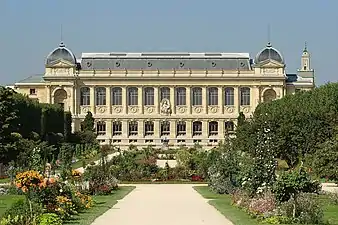 Perspective view from the Jardin des Plantes
Perspective view from the Jardin des Plantes The "Amphithéâtre Richelieu", a Paris-Sorbonne University lecture hall
The "Amphithéâtre Richelieu", a Paris-Sorbonne University lecture hall
Paris region campuses
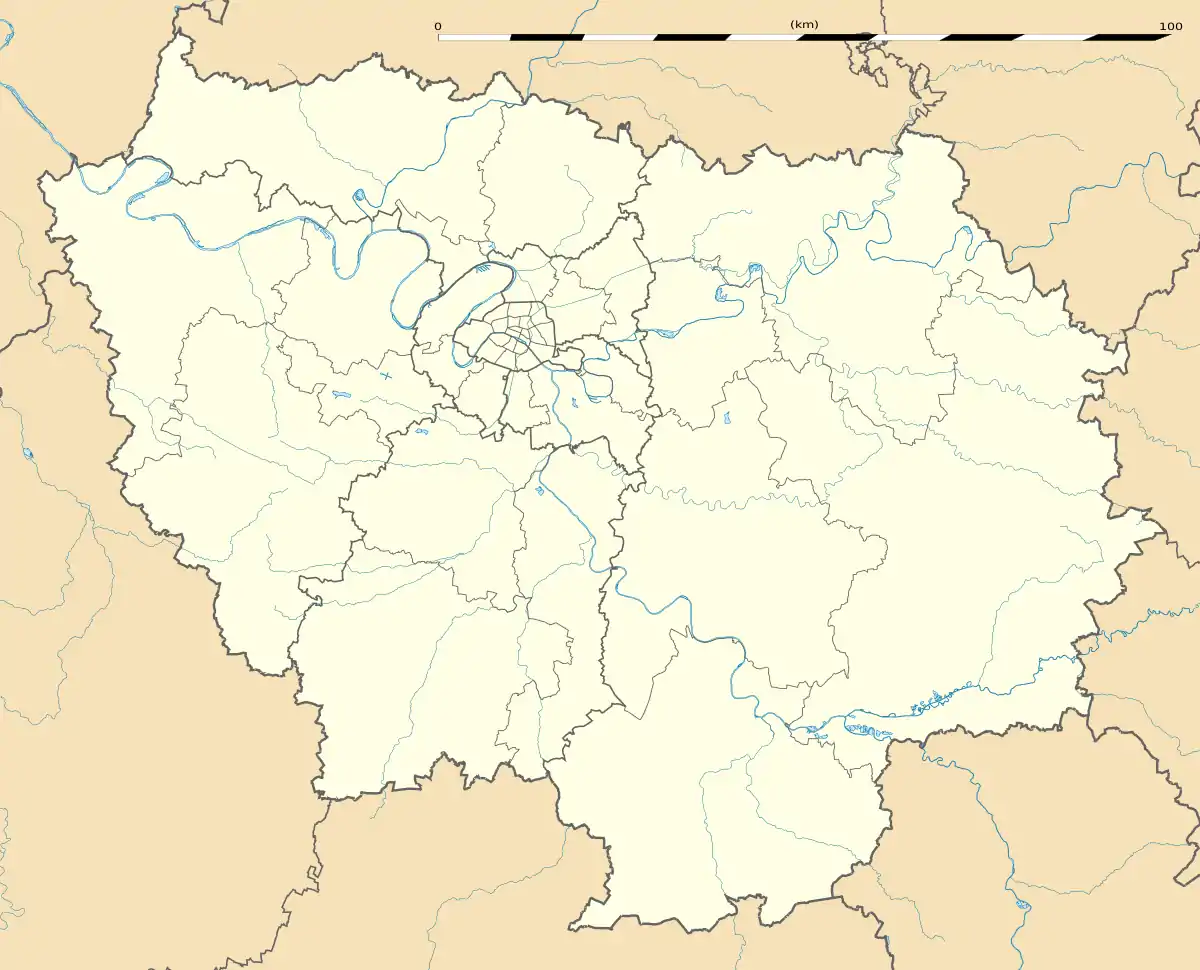
Sorbonne University is also located in other numerous places in the Paris region:[10]
- In Bondy, with the Institute of Research for Development campus, opened in 2013[11]
- In Boulogne-Billancourt, with the Pôle Supérieur d'Enseignement Paris Boulogne-Billancourt
- In Brunoy, with the Center of General Ecology of the National Museum of Natural History
- In Dammarie-les-Lys, with the Didier Lockwood Musical Center, belonging to the Pôle Supérieur d'Enseignement Paris Boulogne-Billancourt
- In Fontainebleau, with the INSEAD campus
- In Ivry-sur-Seine, with the Longevity Institute of the Charles-Foix Hospital, belonging to Pierre and Marie Curie University
- In Menton, with the Jardin botanique du Val Rahmeh, property of the National Museum of Natural History
- In Neuilly-sur-Seine, with Celsa, part of Paris-Sorbonne University
- In Obterre, with the Haute Touche Zoological Park, property of the National Museum of Natural History
- In Rocquencourt, with the Arboretum de Chèvreloup, property of the National Museum of Natural History
- In Saint-Cyr-l'École, with the Jean-Le-Rond-d'Alembert Institute, part of Pierre and Marie Curie University
National campuses

Sorbonne University is also located in numerous other places in France:[12]
- In Banyuls-sur-Mer, with the Observatoire océanologique, belonging to Pierre and Marie Curie University
- In Concarneau, with the Concarneau Biological Station, belonging to the National Museum of Natural History
- In Dinard, with the Centre de recherche et d'enseignement sur les systèmes côtiers, belonging to the National Museum of Natural History
- In Eyzies-de-Tayac-Sireuil, with the prehistoric site called Abri Pataud, property of the National Museum of Natural History
- In Roscoff, with the Station biologique de Roscoff, belonging to Pierre and Marie Curie University
- In Saint-Cyr-l'École, with the Jean-Le-Rond-d'Alembert Institute, part of Pierre and Marie Curie University
- In Samoëns, with the Jaÿsinia Botanical Garden, property of the National Museum of Natural History
- In Sérignan-du-Comtat, with the Harmas de Fabre museum, property of the National Museum of Natural History
- In Villefranche-sur-Mer, with the Villefranche-sur-Mer Marine Station, belonging to Pierre and Marie Curie University
International establishment
.svg.png.webp)
Thanks to its members, Sorbonne University can benefit from a wide range of international partnerships, both in Europe and worldwide. These partnerships allow academic mobility for students and a broader scientific cooperation for researchers. For example, Sorbonne University is also established in Asia, with one campus in Singapore, residence of INSEAD, and two campuses in Abu Dhabi, both for INSEAD and the Paris-Sorbonne University Abu Dhabi.[13]
Sorbonne University has also formed its own academic partnerships: in Canada;[14] Brazil;[15] Mexico, with UNAM;[16] in China with the Harbin Institute of Technology;[17] and in Singapore, with Nanyang Technological University and the Yale-NUS College.[18]
Academic
Members of the group have worked on several projects in order to strengthen relations and potentially create a new international institution. The most famous projects are the "Sorbonne College" (Collège de la Sorbonne) for bachelor's degree teaching and the "Sorbonne Doctoral College" (Collège doctoral de la Sorbonne) for PhD candidates.
The Sorbonne College
Since 2014, the Sorbonne College for bachelor's degree (« Collège des Licences de la Sorbonne ») has been coordinating academic projects of the members of the group. It also offers cross-institutional academic courses in many fields, allowing students to graduate from both institutions. For example, some cross-institutional bachelor's degrees (« double licences ») are proposed to students between Paris-Sorbonne University, Pierre-et-Marie-Curie University, and Panthéon-Assas University, in:
- Science and History (UPMC / Paris-Sorbonne)
- Science and Musicology (UPMC / Paris-Sorbonne)
- Science and Philosophy (UPMC / Paris-Sorbonne)
- Science and Chinese (UPMC / Paris-Sorbonne)
- Science and German (UPMC / Paris-Sorbonne)
- Law and History (Panthéon-Assas / Paris-Sorbonne)
- Law and Art History (Panthéon-Assas / Paris-Sorbonne)
- Law and Science (Panthéon-Assas / UPMC)
- History and Media (Paris-Sorbonne / Panthéon-Assas)[19]
As is the case in the Anglo-American university systems, Sorbonne University proposes a major-minor program that is currently being deployed at Pierre and Marie Curie University.[20]
Sorbonne University, in partnership with INSEAD, also offers all of its alumni and PhD students a professionalizing course in business management, to complete their curriculum.
The Doctoral College
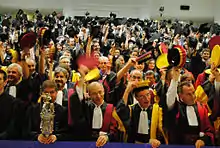
Since 2010, every PhD student is granted an honorary diploma labeled "Sorbonne University". This diploma highlights and gathers the skills of doctors and researchers from the institutions that form Sorbonne University.
The Sorbonne Doctoral College, created in 2013, coordinates the activities of the 26 doctoral schools. Since 2014, it has developed cross-disciplinary PhDs between the different members of the group:
| Fields | Doctoral school | Institution |
|---|---|---|
| Énergie, matière, univers | Chimie physique & chimie analytique de Paris centre | Pierre and Marie Curie University (Paris 6) |
| Physique et chimie des matériaux | Pierre and Marie Curie University (Paris 6) | |
| Chimie moléculaire de Paris centre | Pierre and Marie Curie University (Paris 6) | |
| Astronomie et astrophysique | Pierre and Marie Curie University (Paris 6) | |
| Sciences de la Terre et physique de l'univers | Pierre and Marie Curie University (Paris 6) | |
| Physique en Ile-de-France | Pierre and Marie Curie University (Paris 6) | |
| Modélisation et ingénierie | Informatique, télécommunications & électronique | Pierre and Marie Curie University (Paris 6) |
| Sciences mathématiques de Paris centre | Pierre and Marie Curie University (Paris 6) | |
| Sciences mécaniques, acoustique, électronique et robotique | Pierre and Marie Curie University (Paris 6) | |
| Sciences pour l'ingénieur | University of Technology of Compiègne | |
| Terre vivante et environnement | Sciences de l’environnement | Pierre and Marie Curie University (Paris 6) |
| Géosciences, ressources naturelles et environnement | Pierre and Marie Curie University (Paris 6) | |
| Sciences de la Nature et de l'Homme : évolution et écologie | National Museum of Natural History | |
| Vie et santé | Cerveau, cognition, comportement | Pierre and Marie Curie University (Paris 6) |
| Santé publique & sciences de l’information biomédicale | Pierre and Marie Curie University (Paris 6) | |
| Physiologie, physiopathologie et thérapeutique | Pierre and Marie Curie University (Paris 6) | |
| Complexité du vivant | Pierre and Marie Curie University (Paris 6) | |
| Histoire-Géographie | École doctorale de géographie de Paris | Paris-Sorbonne University (Paris 4) |
| Histoire de l’art et archéologie Paris-Sorbonne | Paris-Sorbonne University (Paris 4) | |
| Histoire moderne et contemporaine | Paris-Sorbonne University (Paris 4) | |
| Mondes anciens et médiévaux | Paris-Sorbonne University (Paris 4) | |
| Langues, lettres et civilisations | Littératures françaises et comparée | Paris-Sorbonne University (Paris 4) |
| Civilisations, cultures et sociétés | Paris-Sorbonne University (Paris 4) | |
| Concepts et Language | Paris-Sorbonne University (Paris 4) | |
| Management | INSEAD PhD program in management | INSEAD |
Since 2011, Sorbonne University has celebrated its graduates in a formal ceremony where every PhD graduate wears a scholar's uniform.[21]
Research
To strengthen the influence of its research infrastructures on the international scale, Sorbonne University has developed several research programs aimed at reinforcing or exploring new fields of study. This innovative cross-disciplinary approach was embodied with the creation of four new academic positions, gathering several establishments of the group:[22]
- A Department of Digital Humanities, exploring the use of digital technologies in the social sciences
- A Department of Polychromatic Studies of Societies, associating architecture, anthropology, chemical physics, literature, and art history
- A Department of Digital Health, exploring biomedical tools
- A Department of 3D Craniofacial Reconstruction
Sorbonne University has also formed, with academic institutions such as the China Scholarship Council or the Brazilian foundation FAPERJ, several partnerships enabling bilateral research programs.
Academic results
| University rankings | |
|---|---|
| Global | |
| ARWU[23] | 35 (PMCU) |
| THE[24] | 103 (PMCU) |
Some of Sorbonne University’ members have recently won fame in global and national university rankings.
Global university rankings
The Academic Ranking of World Universities for 2014-2015 ranks PMCU 35th in the world; 1st French university and 6th university in Europe. In the same edition of the ranking, PMCU is the 4th university for mathematics.[25]
In 2014, Pierre-and-Marie-Curie University was ranked 103rd in the world, 3rd in France, and 29th in the world for physics in the Times Higher Education World University Rankings,[26] while Paris-Sorbonne University is ranked 56th in the world for reputation, 2nd in France.[27]
QS World University Rankings 2015 (world's top 800 universities) ranks Paris-Sorbonne University 1st in France, 36th in the world for arts and humanities (9th for modern languages, 30th for philosophy).
As of 2016, The Financial Times has ranked INSEAD 1st in the world in its Global MBA Rankings.[28]
National university ranking
The main universities and institutions of this group are considered as the first or one of the first universities in their field.
Student life
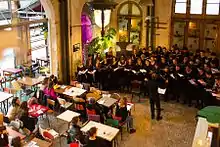
Since 2010, Sorbonne University has set a goal of optimizing students' living conditions and pooling associative activities of all the students.
Associations
Sorbonne University offers financial support to associations or student initiatives that help gather the students of each institution that comprises the group. Among the associations that are currently supported, are:
- The association Doc’Up, founded in 2006, a students’ union that unites PhD students of every member of the group. The association aims at defending PhD students’ rights within the academic representative assemblies and helping them add value to their curriculum.[29] Since 2007, the association has been organizing a scientific popularization short-film festival called « Les chercheurs font leur cinéma » (« Researchers create cinema »).[30]
- In 2014, the music festival Imaginarium was founded by students of the UTC[31]
Sorbonne University also supports students' welcoming initiatives at the beginning of the fall term, such as :
- Les Sorbonnales, a cross-institutional student ball that gathers every student of Sorbonne University. The sixth edition of the ball took place in 2014[32]
- Since 2012, a welcome week has been organized at Pierre and Marie Curie University[33]
Culture

Since 2012, Sorbonne University has organized an eloquence contest called « Fleurs d’Éloquence », during which every Sorbonne University student can compete. 150 students participated in 2015.[34]
Sorbonne University has its own musical ensemble, called Chœur-Orchestre Sorbonne-Universités (Sorbonne University Choir & Orchestra). COSU gathers 250 students, instrumentalists, and vocalists, who perform throughout the school year in concert halls, such as Sorbonne’s Grand Amphitheater, or in other parts of Europe.[35]
Sports
Each member of Sorbonne University provides its own range of sporting activities. Nevertheless, the members have recently begun to consolidate their sports facilities following the renovation of the Jussieu Campus: the new Jean-Talbot gymnasium was opened in the fall of 2014, and has since then become the venue for indoor sports.[36]
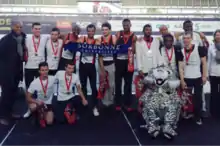
Sorbonne University also takes part in student sport competitions, where it competes with other establishments. In 2014, Sorbonne University won 3rd place in the World Championships of Grandes Écoles and Universities, a competition jointly organized by the French Athletics Federation and the Journal of Grandes Écoles and Universities, a French magazine for students.[37]
Notable teachers and alumni
|
Faculty Nobel Prizes | ||
|---|---|---|
| Gérard Mourou[38] | Physics | 2018 |
| Serge Haroche[39] | Physics | 2012 |
| Françoise Barré-Sinoussi[40] | Physiology or Medicine | 2008 |
| Claude Cohen-Tannoudji[41] | Physics | 1997 |
| Pierre-Gilles de Gennes[42] | Physics | 1991 |
| Maurice Allais[43] | Economic Sciences | 1988 |
| Alfred Kastler[44] | Physics | 1966 |
| François Jacob[45] | Physiology or Medicine | 1965 |
| André Lwoff[46] | Physiology or Medicine | 1965 |
| Jacques Monod[47] | Physiology or Medicine | 1965 |
| Frédéric Joliot[48] | Chemistry | 1935 |
| Irène Joliot-Curie[49] | Chemistry | 1935 |
| Louis de Broglie[50] | Physics | 1929 |
| Jean-Baptiste Perrin[51] | Physics | 1926 |
| Charles Richet[52] | Physiology or Medicine | 1913 |
| Marie Curie[53] | Chemistry | 1911 |
| Gabriel Lippmann[54] | Physics | 1908 |
| Henri Moissan[55] | Chemistry | 1906 |
| Henri Becquerel[56] | Physics | 1903 |
| Marie Curie[57] | Physics | 1903 |
13 Nobel laureates[58] have been faculty members, researchers, or alumni, along with 7 Field Medalists:[59]
- Artur Avila (2014)
- Cédric Villani (2010)
- Wendelin Werner (2006)
- Pierre-Louis Lions (2004)
- Alain Connes (1982)
- René-Frédéric Thom (1958)
- Jean-Pierre Serre (1954)
Sorbonne University has many notable teachers, some of whom have themselves graduated from the members of the group:
- Pierre-and-Marie-Curie University: Alain Carpentier, surgeon and cardiologist, Lasker award; Alain Fuchs, president of CNRS;[60] Serge Haroche, Nobel prize for Physics
- Paris-Sorbonne University: Jean-Luc Marion, philosopher, member of the Académie française;[61] Jean Tulard, historian, member of the Académie des Sciences morales et politiques
- University of Technology of Compiègne: Yann Moulier-Boutang, economist and essayist;[62] Bernard Stiegler, philosopher and member of the French Digital Council
Some Sorbonne University alumni have achieved prominence in many fields, such as politics, sports, or economics :
- Claude Bartolone, president of the French Assemblée Nationale (PMCU)
- Ulrich Robeiri, French épée fencer, World Champion in 2014, team Olympic Champion in 2008[63] (PMCU)
- Marie Gayot, French sprint athlete, 2014 European Athletics Championship 4 × 400 m relay gold medalist[64] (UTC)
- Robert S. Keane, CEO, Vistaprint (INSEAD)
- Johann Schneider-Ammann, Swiss minister of Economy (INSEAD)
- Andrew Noble, 2010 Winter Olympics Alpine Skiing competitor (INSEAD)
- Bernard de la Villardière, French journalist, radio and TV presenter[65] (CELSA – PSU)
- Frédéric Beigbeder, French writer and literary critic[66] (CELSA – PSU)
References
- Le Figaro, Le retour de la grande université de Paris
- "Universités : Paris 2, 4 et 6 s'unissent". Le Figaro (in French). 2 October 2009.
- "Paris 2, 4 et 6 changent de nom". Le Figaro (in French). 25 February 2010.
- List of PMCU's Nobel Prize laureates
- List of PMCU's Field Medalists
- Jay, Clarisse (6 April 2011). "Opération campus : Pécresse distribue les enveloppes à Paris". La Tribune (in French).
- "Universités : Paris 2, 4 et 6 s'unissent". Le Figaro (in French). 2 October 2009.
- "Paris 2, 4 et 6 changent de nom". Le Figaro (in French). 25 February 2010.
- Study International, Consolidation of two elite Paris universities confirmed for 2018
- (in French) List of Sorbonne University's establishments
- (in French) Inauguration du campus de Bondy, site de l'académie de Créteil Archived 2014-07-03 at the Wayback Machine
- (in French) List of Sorbonne University's establishments
- (in French)« La direction de l’Insead quitte la France pour Singapour »
- (in French)Bourse de recherche Mitacs Globalink - Sorbonne Universités (2e et 3e cycles) Archived 2015-06-23 at the Wayback Machine
- (in French)Présentation du partenariat avec le Brésil sur le site de Sorbonne Universités
- (in French)« Partenariat entre Sorbonne Universités et la plus grande université du Mexique »
- (in French)« 11 accords signés à Pékin pour l'enseignement supérieur et la recherche »
- (in French)Presentation of the partnership with Singapore, Sorbonne University's website
- [Éléad, Les cursus sélectifs des grandes universités parisiennes , les doubles licences http://elead.fr/cursus-selectifs-grandes-universites-parisiennes/
- (in French) « La Sorbonne université d’élite et de masse: entretien avec Barthélémy Jobert, président de l’université Paris Sorbonne », Le Monde.fr
- (in French) « Sorbonne Universités célèbre ses docteurs... à l'américaine », EducPros.fr, 17 mai 2011
- (in French) http://www.sorbonne-universites.fr/actions/recherche/chaires-thematiques/ Presentation of Sorbonne University's new academic positions]
- "Academic Ranking of World Universities 2020". Shanghai Ranking Consultancy. 2020. Retrieved August 15, 2020.
- "World University Rankings 2021". THE Education Ltd. Retrieved September 2, 2020.
- (in French)« Classement de Shanghaï : les universités françaises maintiennent leur rang », www.lemonde.fr
- World University Rankings 2014-2015
- World University Rankings 2014-2015
- (in French) Les actions de Doc'Up Archived 2015-06-18 at the Wayback Machine
- (in French) « Les chercheurs font leur cinéma, ou les doctorants derrière la caméra »
- (in French)« L’Imaginarium Festival remballe satisfait »
- (in French) The Sorbonnales' website
- (in French) « Rentrée étudiante : les pratiques innovantes des universités et grandes écoles »
- (in French) « Les concours d’éloquence, un phénomène persuasif », www.lemonde.fr
- (in French) COSU's website
- (in French)
- (in French) 2014 Challenge du Monde des Grandes écoles et universités prize list
- "The Nobel Prize in Physics 2018". Nobel Foundation.
- "The Nobel Prize in Physics 2012". Nobel Foundation.
- "The Nobel Prize in Physiology or Medicine 2008". Nobel Foundation.
- "The Nobel Prize in Physics 1997". Nobel Foundation.
- "The Nobel Prize in Physics 1991". Nobel Foundation.
- "The Nobel Prize in Economic Sciences 1988". Nobel Foundation.
- "The Nobel Prize in Physics 1966". Nobel Foundation.
- "The Nobel Prize in Physiology or Medicine 1965". Nobel Foundation.
- "The Nobel Prize in Physiology or Medicine 1965". Nobel Foundation.
- "The Nobel Prize in Physiology or Medicine 1965". Nobel Foundation.
- "The Nobel Prize in Chemistry 1935". Nobel Foundation.
- "The Nobel Prize in Chemistry 1935". Nobel Foundation.
- "The Nobel Prize in Physics 1929". Nobel Foundation.
- "The Nobel Prize in Physics 1926". Nobel Foundation.
- "The Nobel Prize in Physiology or Medicine 1913". Nobel Foundation.
- "The Nobel Prize in Chemistry 1911". Nobel Foundation.
- "The Nobel Prize in Physics 1908". Nobel Foundation.
- "The Nobel Prize in Chemistry 1906". Nobel Foundation.
- "The Nobel Prize in Physics 1903". Nobel Foundation.
- "The Nobel Prize in Physics 1903". Nobel Foundation.
- List of PMCU's Nobel laureates
- List of PMCU's Nobel Laureates
- (in French)« Alain Fuchs, un pédagogue à la tête du CNRS », www.industrie-techno.com
- (in French)« Le philosophe Jean-Luc Marion élu à l'Académie française », www.lemonde.fr
- (in French)« L'Abeille et l'économiste, de Yann Moulier Boutang », www.lemonde.fr
- "Ulrich Robeiri, French épée fencer and graduate of UPMC"
- (in French)"Marie Gayot, à Compiègne et Miami en attendant Rio", www.courrier-picard.fr
- (in French)"Bernard de la Villardière: anatomie d'un ovni", www.lenouveleconomiste.fr
- (in French)"Le prix Renaudot attribué à Frédéric Beigbeder", www.lemonde.fr